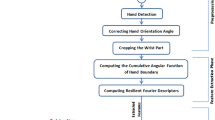Abstract
Hitherto, one major challenge to sign language recognition is how to develop approaches that scale well with increasing vocabulary size. In large vocabulary speech recognition realm, it is effective to use phonemes instead of words as the basic units. This idea can be used in large vocabulary Sign Language recognition, too. In this paper, Etyma are defined to be the smallest unit in a sign language, that is, a unit that has some meaning and distinguishes one sign from the others. They can be seen as phonemes in Sign Language. Two approaches to large vocabulary Chinese Sign Languagerecognition are discussed in this paper. One uses etyma and the other uses whole signs as the basic units. Two CyberGloves and a Pohelmus 3-D tracker with three receivers positioned on the wrist of CyberGlove and the back are used as input device. Etymon- and word- based recognition systems are introduced, which are designed to recognize 2439 etyma and 5100 signs. And then the experimental results of these two systems are given and analyzed.
This research is sponsored by Natural Science Foundation of China (No. 60533030).
Preview
Unable to display preview. Download preview PDF.
Similar content being viewed by others
References
Starner, T., Weaver, J., Pentland, A.: Real-Time American Sign Language Recognition Using Desk and Wearable Computer Based Video. IEEE PAMI 20(12), 1371–1375 (1998)
Fels, S.S., Hinton, G.: GloveTalk: A neural network interface between a DataDlove and a speech synthesizer. IEEE Transactions on Neural Networks 4, 2–8 (1993)
Sidney Fels, S.: Glove –TalkII: Mapping hand gestures to speech using neural networks-An approach to building adaptive interfaces. PhD thesis, Computer Science Department, University of Torono (1994)
Liang, R.-H., Ouhyoung, M.: A real-time continuous gesture recognition system for sign language. In: Proceeding of the Third International Conference on Automatic Face and Gesture Recognition, Nara, Japan, pp. 558–565 (1998)
Wang, C., Gao, W.: A Real-time Large Vocabulary Recognition Continuous System for Chinese Sign Language. In: Shum, H.-Y., Liao, M., Chang, S.-F. (eds.) PCM 2001. LNCS, vol. 2195, pp. 150–157. Springer, Heidelberg (2001)
Vogler, C., Metaxas, D.: Toward scalability in ASL Recognition: Breaking Down Signs into Phonemes. In: Proceedings of Gesture Workshop, Gif-sur-Yvette, France, pp. 400–404 (1999)
Wang, C., Gao, W., Shan, S.: An approach based on phonemes to large vocabulary Chinese sign language recognition. In: Proceeding of the Fifth IEEE International Conference on Automatic Face and Gesture Recognition (FG 2002), Washington, USA, pp. 411–416 (2002)
Author information
Authors and Affiliations
Editor information
Editors and Affiliations
Rights and permissions
Copyright information
© 2006 Springer-Verlag Berlin Heidelberg
About this paper
Cite this paper
Wang, C., Chen, X., Gao, W. (2006). A Comparison Between Etymon- and Word-Based Chinese Sign Language Recognition Systems. In: Gibet, S., Courty, N., Kamp, JF. (eds) Gesture in Human-Computer Interaction and Simulation. GW 2005. Lecture Notes in Computer Science(), vol 3881. Springer, Berlin, Heidelberg. https://doi.org/10.1007/11678816_10
Download citation
DOI: https://doi.org/10.1007/11678816_10
Publisher Name: Springer, Berlin, Heidelberg
Print ISBN: 978-3-540-32624-3
Online ISBN: 978-3-540-32625-0
eBook Packages: Computer ScienceComputer Science (R0)




